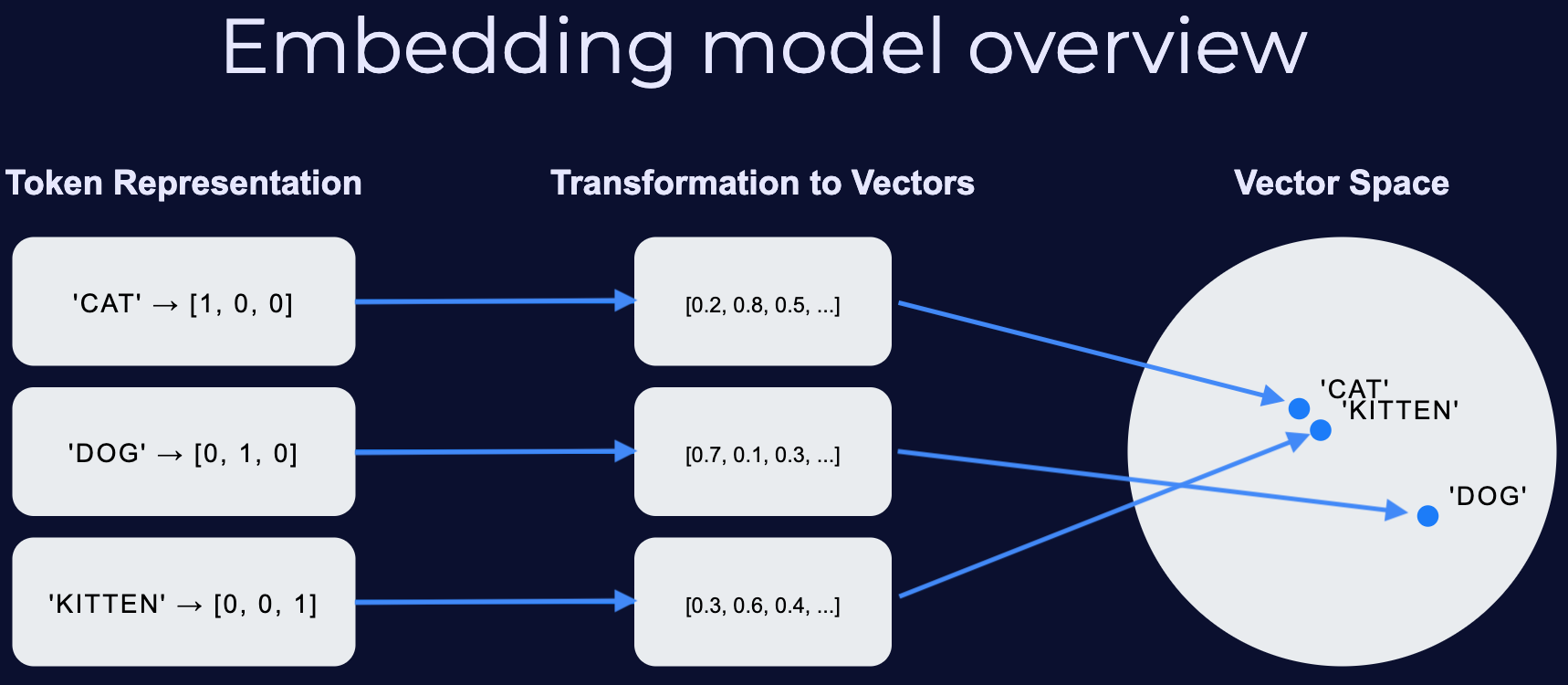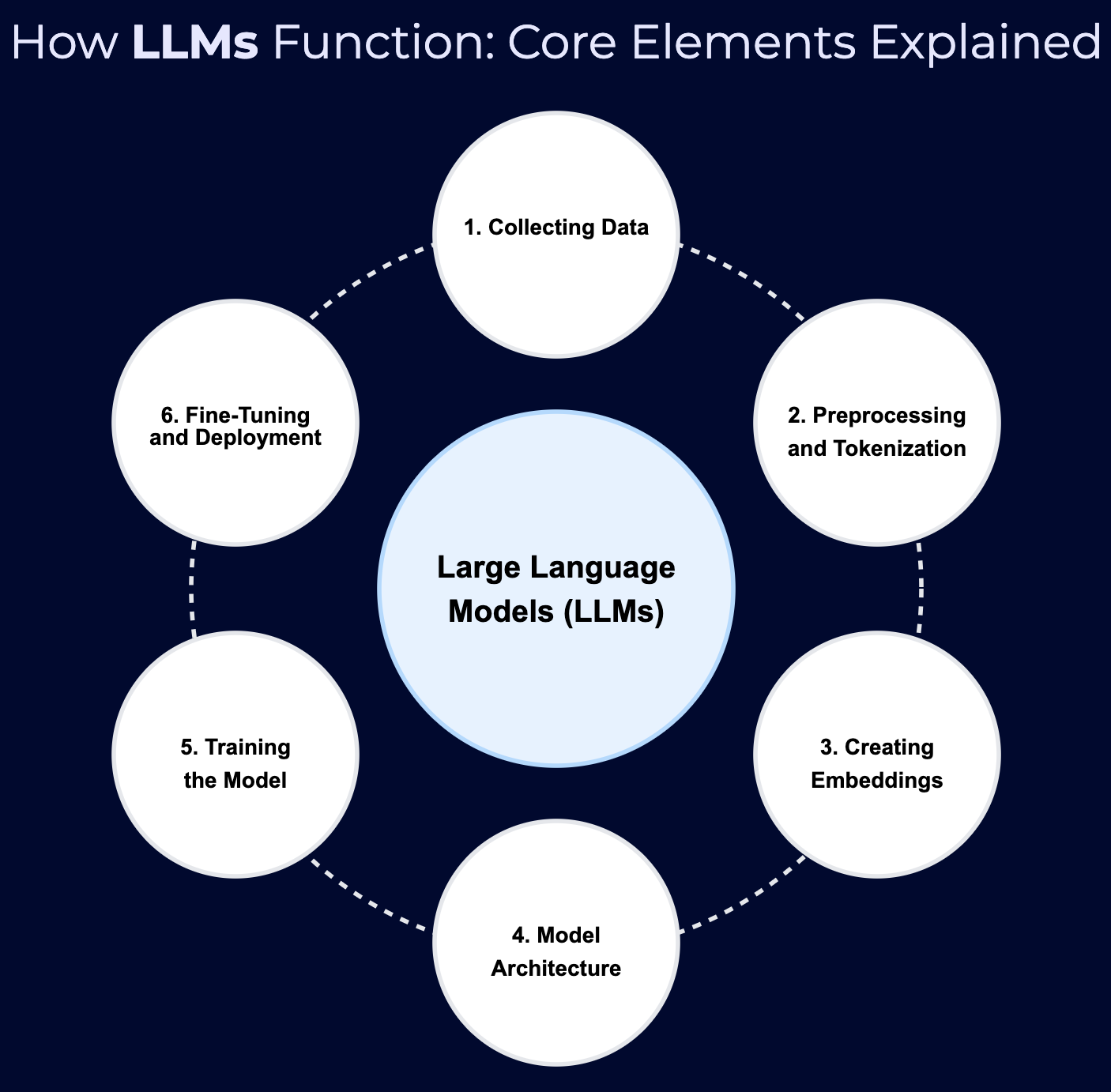In the last two years, there has been massive growth in generative AI, with market size projected to grow from USD 20.9 billion in 2024 to USD 136.7 billion by 2030 at a compound annual growth rate of 36.7% according to MarketsandMarkets Research. This is one of the biggest disruptions in the digital age, enabling organizations to make sense of their data to lower operational costs and enhance decision-making.
One key piece behind this success is embedding models, which power large language models (LLMs). While LLMs and embedding models are related, they perform very different tasks. This post covers what embedding models are, how they work, and why they’re essential building blocks of LLMs and many AI systems.

What Are Embedding Models?
Embedding models transform data—words, sentences, images, audio—into numerical representations (vectors) that models can operate on. They embed items into a vector space based on relationships: closely related items are near each other; unrelated items are far apart. This allows AI systems to compute similarities and generate relevant content from user inputs (prompts).
What Is the Difference Between LLMs and Embedding Models?
LLMs don’t “understand” language directly; they understand numerical relationships between tokens. Embeddings bridge that gap: they encode inputs into vectors LLMs can process.
Unlike LLMs, embedding models do not generate content; they encode data into vectors for comparison and analysis (often stored in a vector database). Many LLM systems include an embedding step for retrieval, ranking, or memory.
Essential Components of Large Language Models
 The Building Blocks of LLM Models
The Building Blocks of LLM Models
1. Collecting Data
Building an LLM requires large, diverse datasets (web pages, social media, books, blogs). More and better data enables models to learn richer patterns and produce higher-quality outputs.
2. Preprocessing and Tokenization
Content is broken into tokens (words or subwords). Tokens are the basic units LLMs operate on.
3. Creating Embeddings
Embeddings transform tokens into vectors—numerical representations that capture meaning and relationships. Tokens with similar meanings (e.g., “cat” and “kitten”) have similar vectors, enabling models to recognize semantic relatedness.
4. Model Architecture
Modern LLMs use transformer architectures introduced in the 2017 paper, “Attention Is All You Need.” Transformers take token embeddings and apply attention mechanisms to model relationships in sequences, enabling generation of output text given input context.
5. Training the Model
Models are trained to predict tokens and their relationships, adjusting internal parameters iteratively. This demands significant compute. After training, users can interact via natural language and receive outputs (text, images, audio).
6. Fine-Tuning and Deployment
Models can be fine-tuned for specific tasks. Once validated, they are deployed in applications like chatbots, virtual assistants, document analysis tools, and more.
Understanding Embeddings
Embedding models convert content into vectors so ML systems can reason about meaning and context.
 How an embedding model works
How an embedding model works
Early methods used one-hot encodings—placing tokens as orthogonal vectors—capturing no semantic relations and leading to inefficiencies. More recent semantic embeddings create vector spaces where similar content is nearby, enabling fast retrieval and better downstream performance.
Types of Embeddings, Use Cases, and Tools
| Type | Description | Use Case | Example Tool/Model |
|---|---|---|---|
| Word Embeddings | Dense vectors for words capturing semantic relations | Improve keyword relevance in search | Word2Vec |
| Sentence Embeddings | Vectors representing entire sentences in context | Document similarity detection | Sentence Transformers |
| Image Embeddings | Vectors capturing visual features | Image retrieval (find similar images) | TensorFlow Image Embedding API |
| Audio Embeddings | Vectors capturing salient audio features | Speech recognition | Whisper |
| Contextual Embeddings | Context-dependent vectors for the same token | Machine translation, NLU | BERT (Bidirectional Encoder Representations from Transformers) |
| Graph Embeddings | Vectors for nodes/graphs capturing relationships | Fraud detection via transaction patterns | Node2Vec |
| Multimodal Embeddings | Joint representations across text/images/audio | Interactive AI integrating multiple inputs | CLIP |
Classical vs. Semantic Approaches in Embeddings
As NLP has evolved, semantic approaches have transformed how machines represent and generate language.
Overview
| Aspect | Classical Approaches | Semantic Approaches |
|---|---|---|
| Main Techniques | One-hot, Count-based, TF-IDF, N-grams | Word2Vec, GloVe, ELMo |
| Context Consideration | Limited/none | Context-aware, semantic |
| Dimensionality | High-dimensional (e.g., vocab-size one-hot) | Lower-dimensional, dense |
| Semantic Capture | Limited | Strong |
| Long-distance Dependencies | Poor | Better (esp. with ELMo/transformers) |
| Training Method | Statistical/frequency | Neural predictive models |
| Scalability | Often more scalable (TF-IDF, count) | Less scalable; more complex training |
| Training Speed | Faster | Slower |
| Accuracy | Lower for complex NLP tasks | Higher, especially context-dependent |
| Flexibility | Fixed representations | Context-dependent, flexible |
| Handling Unseen Words | Poor | Better for rare/unseen |
| Applications | Basic NLP, IR | Sentiment, MT, QA, summarization, NLU |
1) Classical Approach
- Bag of Words (BoW): Document vectors of word frequencies; ignores context, yields sparse vectors.
- TF-IDF: Down-weights common terms, up-weights informative rare terms.
- Co-occurrence Matrices: Track proximity of words; still lacks semantic understanding.
Efficient for smaller datasets but weak on contextual meaning and generalization.
2) Semantic Approach (Embedding + LLM)
- Word Embeddings (Word2Vec, GloVe): Dense vectors place semantically similar words nearby.
- Contextual Embeddings (BERT, GPT-family): Vectors vary by surrounding context.
- Fine-Tuning & Transfer: Pretrained models can be adapted to many downstream tasks (QA, summarization, NLU, etc.).
This approach captures nuance in meaning, context, and syntax, improving accuracy and generalization across tasks.
Conclusion
Embeddings are foundational to LLMs, enabling them to “understand” human language or other data well enough to generate text, images, or audio. Without embeddings, we wouldn’t have today’s generative AI systems.
For businesses, leveraging embeddings effectively requires infrastructure and integration across open-source components—work that can take up to two years to build in-house. ConfidentialMind reduces this complexity by providing a platform to build secure AI systems and integrate AI into products and services.